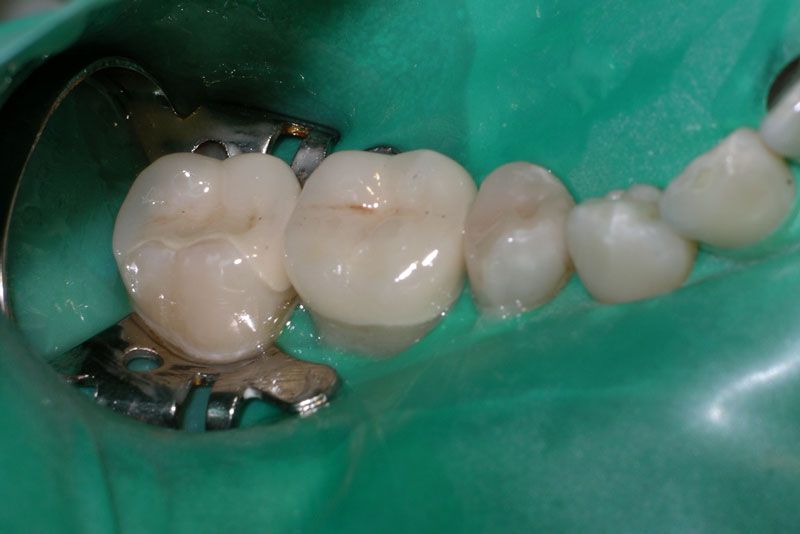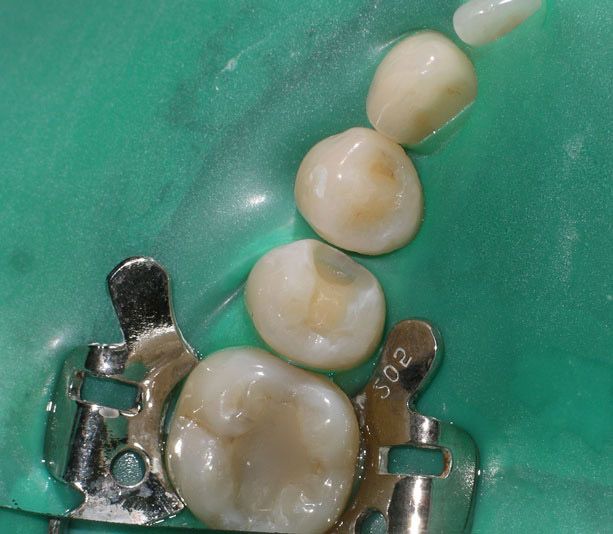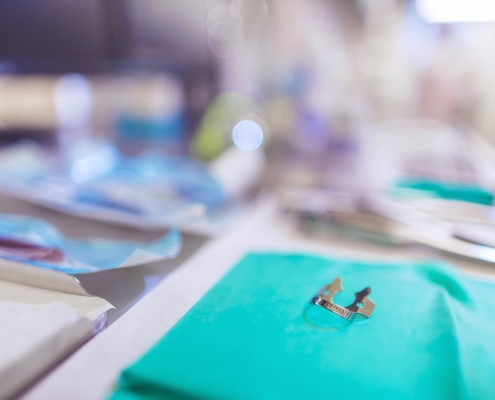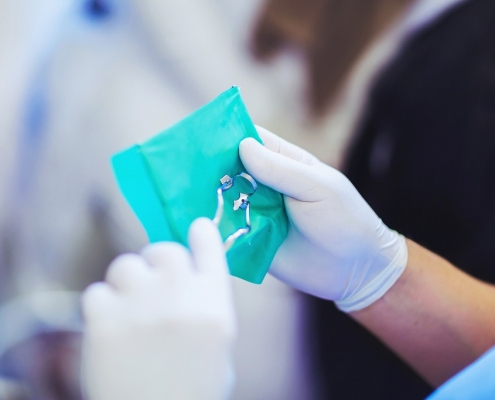
In dental medicine, a cofferdam is a thin rubber membrane that is used in a number of dental procedures to keep the tooth dry during treatment and isolate it from the rest of the oral cavity. The cofferdam looks back on a long tradition of its use in dentistry. It was invented by a New York dentist who was looking for a solution to the problem of the steadily flowing saliva during a dental treatment.
From 1864, the year of its introduction, till the early 20th century, the cofferdam was a standard tool of a dentist’s craft. But as soon as electrical suction pumps were invented, the somewhat cumbersome rubber membrane was readily abandoned. It was all but forgotten in general dental practice, when modern endodontics and the work with composite filling materials brought it back in the 1990s. Today, the cofferdam is again an indispensable part of good practice in dental procedures like root canals and amalgam removal, and a necessary tool when working with adhesive bonding techniques. The somewhat strange sounding name is an engineering term: In the engineering context, a cofferdam is a form of temporary damming to drain certain areas, e.g. during construction of a bridge – and, obviously, something quite similar is accomplished by the cofferdam in dentistry, too.
Advantages of the cofferdam:
- Treatment quality: Dry, clean work area for the dentist. No suctioning necessary – dentist and assistants can use their hands freely during the procedure.
- Treatment safety: The membrane protects the oral cavity from foreign objects and chemicals used/released during the treatment.
- Protection from infection: The cofferdam works both ways as an impenetrable barrier for bacteria between oral cavity and tooth/outside.
This is how we put on the cofferdam
The cofferdam membrane consists of latex of varying thicknesses (for patients with a latex allergy there are silicone alternatives). It is spanned across a frame and positioned over the entire oral cavity. For the tooth/teeth awaiting treatment, one or several small perforations are punched into the membrane, and the cofferdam is fastened to the tooth/teeth with a metal clip.
As a patient, you will likely feel a bit of an unpleasant sensation of pressure against the gingiva. Sometimes, little injuries of the gums can’t be avoided. As you will have to breathe through your nose, application of the cofferdam requires unblocked nasal passages. But with a cold and a stuffy nose, you’d better postpone those scheduled dental appointments anyway…

Cofferdam in endodontics
Application of the cofferdam contributes greatly to the success of a root canal treatment. A) It prevents bacteria from saliva from entering the exposed and freshly disinfected root canals. B) It keeps bacteria from the root canals away from the oral cavity and protects the gums from the aggressive irrigation solutions used for cleaning the canals. C) It prevents accidental swallowing or aspiration of one of the tiny instruments the dentist is using on the root canals.
The latter is a real danger in endodontics: Without a cofferdam, one startled movement or coughing fit of the patient can have very unpleasant consequences. For those reasons, the European Endodontic Society has deemed in their quality guidelines the use of a cofferdam necessary for every root canal treatment.
Cofferdam and the placement of ceramic inlays and composite fillings
Adhesive dentistry, i.e. the bonding of ceramic inlays and composite fillings to enamel and dentin, requires absolute dryness. Saliva, blood, or even the moisture in the exhaled air jeopardize the quality of the result, as the water repellant composite adhesive that is used during these procedures does not adhere well to moist surfaces. Moisture compromises the bond between inlay or filling and tooth substance and leads to the formation of tiny crevices that may harbor bacteria and increase the risk of secondary caries. Also, the stabilizing effect of an inlay on a tooth with a large cavity and thin remaining walls is much reduced.
When working with the adhesive technique, the cofferdam provides dry surroundings. Thus, ceramic inlays should never be placed without a cofferdam. With composite fillings, one must weigh the options of a low-price, very economic solution and a more long-lived solution on the other hand, as using the cofferdam will, of course, increase the very low price of a composite filling a bit. However, due diligence during the placement of more complex, multi-layered composite restorations requires the use of a cofferdam.
Cofferdam during amalgam removal
During the removal of amalgam fillings, more mercury is released in a short time than would leak from the intact fillings in the course of many years. This is why the cofferdam is an indispensable security measure during amalgam removal: You should insist on its use, even more so, if you have the fillings removed for health concerns – otherwise, the well-intentioned measure may turn out to be somewhat counterproductive.
The cofferdam protects you from swallowing and breathing amalgam dust and mercury vapours during the drilling-out of the amalgam fillings. Make sure your dentist has effective protection in place for your nose, too. Responsible amalgam removal also involves a special drilling protocol with a slower drill and some cooling measures that minimize the release of mercury vapours caused by the heat during the drilling. Other possible uses of the cofferdam include bleaching, and adhesive bonding of the brackets for orthodontic braces. In its areas of use, the cofferdam technique considerably improves treatment safety and outcome quality. These big advantages come at a very small cost: some careful training on the side of the dentist, and some patience and tolerance for a procedure that might at first feel a little strange and uncomfortable on the side of the patient.
Any other questions about the cofferdam? Don’t hesitate to ask us in person!






